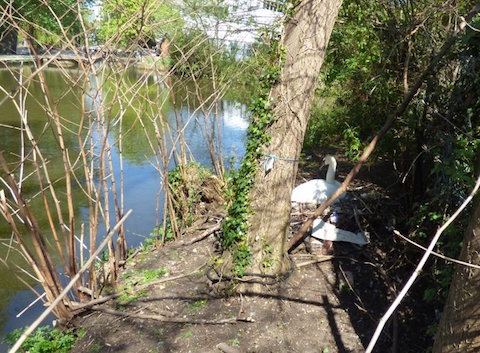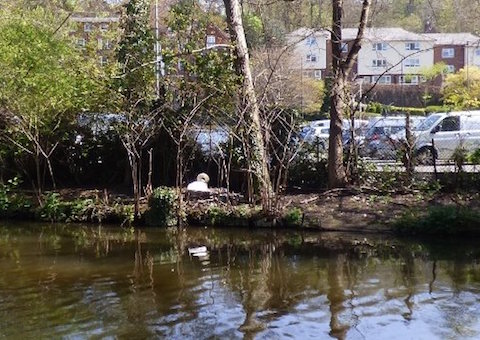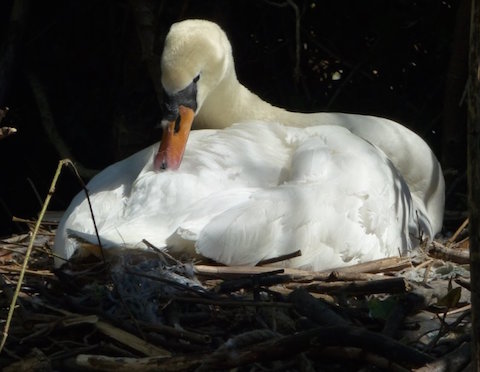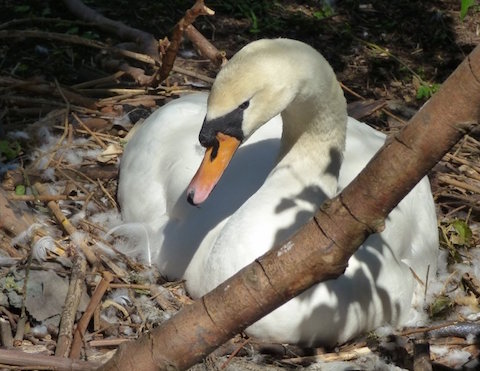 Abraham Lincoln
If given the truth, the people can be depended upon to meet any national crisis...
Abraham Lincoln
If given the truth, the people can be depended upon to meet any national crisis...
 Guildford news...
for Guildford people, brought to you by Guildford reporters - Guildford's own news service
Guildford news...
for Guildford people, brought to you by Guildford reporters - Guildford's own news service
Swan Lock – Photo feature
Published on: 27 Apr, 2015
Updated on: 2 May, 2015
Photography by Malcolm Fincham
Swanning about in Guildford is no joke when it’s spring time and a cob’s fancy turns to raising a family.
The big question is where to build your nest to minimise the risk from pesky predators.
A pair of swans in Millmead, seemingly aware of the local housing problems, have gone for the town centre option, next to a busy car park, utilising a brownfield site.

This photograph shows that these swans have chosen a site that while in full view has limited accessibility and should be more difficult for their main predators, foxes, to reach.
Passers by on the opposite tow path are able to easily monitor the pair’s progress and simply admire these beautiful birds.
If you take photographs you would like to share, perhaps of the cygnets once they hatch, please send them in to: guildford.dragon@gmail.com.
A dozen mute swan facts:
Origins: Despite a Eurasian origin, the mute swan’s closest relatives are the black swan of Australia and the black-necked swan of South America, not other northern hemisphere swans. The name ‘mute’ derives from it being less vocal than other swan species.
Behaviour: Mute swans are usually strongly territorial. They are more aggressive during the nesting season because they need to protect their nest, eggs and chicks.
Mates for life: Swans usually mate for life, remaining together through the year, but “divorces” have been known, and if one of a pair dies, the survivor usually seeks out a new mate, and the pair remain devoted.
Mating: Swans begin to breed between 3 and 4 years of age. It’s a special treat to see swan mates “displaying” during the mating season, gracefully touching bill-to-bill and breast-to-breast until a perfect heart shape is formed, or gently intertwining their necks.
Eggs: They lay from 5 to 10 eggs that take from 35 to 42 days to hatch. The female does most of the egg incubation, but every now and then the male will replace her for a while so she can have a swim and feed.
Food: An adult swan eats about 4kg of aquatic vegetation every day, sometimes insects, even tiny fish and tadpoles. It reaches underwater plants by plunging its long neck into the water, or ‘upending’, tail in the air. To help with the digestion of these plants in its gizzard, or second stomach, the swan swallows grit which grinds up the food.
Lifetime: A swan in a protected environment might live as long as 30 years.
Neck: A mute swan’s neck has 23 vertebrae, more than any other bird.
Feathers: A swan has some 25,000 feathers.
Gender: Males or cobs are larger than females or pens; the knob at the base of the male’s upper bill is larger than that of the female’s and swells during the mating season. By the way, it’s this knob that distinguishes the mute swan from all others; the neck of a male is thicker than the neck of a female.
Weight: Swans are one of the heaviest flying birds. Males weigh, on average, from about 10.6 to 11.87 kg (23.4 to 26.2 lb).
Legal protection: As native wild birds, swans enjoy statutory protection. It is an offence to intentionally injure, take or kill a wild swan. Eggs and nests are similarly protected. It is an offence to take or possess the egg of a wild mute swan, or to damage or destroy the nest of a mute swan whilst in use or being built.
Responses to Swan Lock – Photo feature
Leave a Comment Cancel replyPlease see our comments policy. All comments are moderated and may take time to appear.
Recent Articles
- Guildford Institute’s Crowdfunding Project for Accessible Toilet in its New Community and Wellbeing Centre
- Letter: Guildford – Another Opportunity Missed?
- Letter: GBC’s Corporate Strategy – Where Is the Ambition?
- My Memories of John Mayall at a Ground-breaking Gig in Guildford Nearly Six Decades Ago
- Westborough HMO Plans ‘Losing the Heart of the Street’ Says Resident
- College Invests to Boost Surrey’s Economy and Close Digital Skills Gap
- Community Lottery Brings Big Wins for Local Charities
- GBC Housing Plan Promises ‘A Vibrant Urban Neighbourhood’ Near Town Centre
- Hospital Pillows ‘Shortage’ at the Royal Surrey
- Updated: Caravans Set Up Camp at Ash Manor School


Recent Comments
- Ian Macpherson on Updated: Main Guildford to Godalming Road Closed Until August 1
- Sara Tokunaga on GBC Housing Plan Promises ‘A Vibrant Urban Neighbourhood’ Near Town Centre
- Michael Courtnage on Daily Mail Online Reports Guildford Has Highest-paid Council Officer
- Alan Judge on GBC Housing Plan Promises ‘A Vibrant Urban Neighbourhood’ Near Town Centre
- John Perkins on GBC Housing Plan Promises ‘A Vibrant Urban Neighbourhood’ Near Town Centre
- S Collins on GBC Housing Plan Promises ‘A Vibrant Urban Neighbourhood’ Near Town Centre
Search in Site
Media Gallery
Dragon Interview: Local Artist Leaves Her Mark At One of England’s Most Historic Buildings
January 21, 2023 / No Comment / Read MoreDragon Interview: Lib Dem Planning Chair: ‘Current Policy Doesn’t Work for Local People’
January 19, 2023 / No Comment / Read MoreA3 Tunnel in Guildford ‘Necessary’ for New Homes, Says Guildford’s MP
January 10, 2023 / No Comment / Read More‘Madness’ for London Road Scheme to Go Ahead Against ‘Huge Opposition’, Says SCC Leader
January 6, 2023 / No Comment / Read MoreCouncillor’s Son Starts Campaign for More Consultation on North Street Plan
December 30, 2022 / No Comment / Read MoreCounty Council Climbs Down Over London Road Works – Further ‘Engagement’ Period Announced
December 14, 2022 / No Comment / Read MoreDragon Interview: GBC Reaction to the Government’s Expected Decision to Relax Housing Targets
December 7, 2022 / No Comment / Read MoreHow Can Our Town Centre Businesses Recover? Watch the Shop Front Debate
May 18, 2020 / No Comment / Read More












Kathy Whitley
May 6, 2015 at 11:34 am
Fantastic. I loved the video.
Jenny Davis
May 31, 2015 at 6:45 pm
Lovely picture but since 19 May these swans and their 9 cygnets have apparently not been seen. Does anyone know what has happened to them?